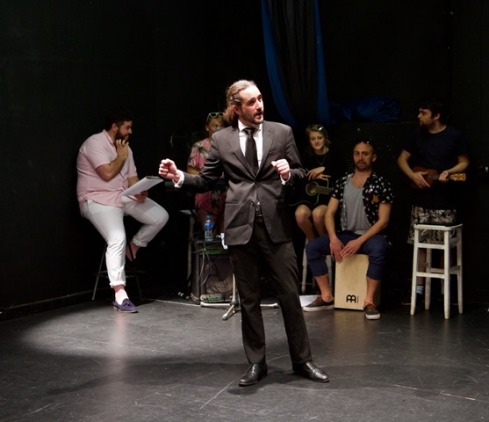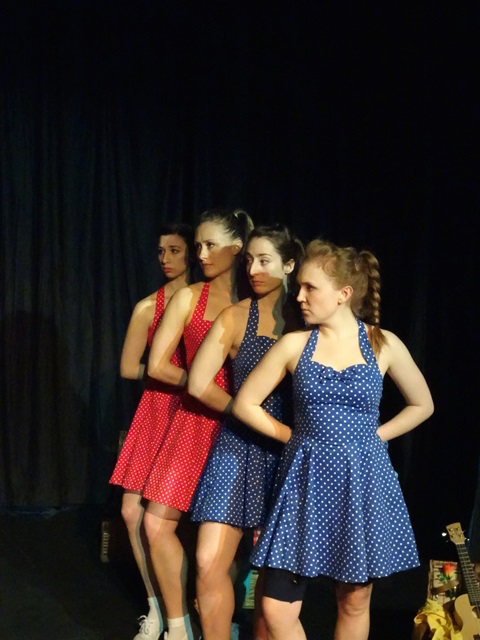The Tricycle
Blue Elephant, 21.11.17, with Anna
The Tricycle is a 1952 play by the Spanish absurdist playwright Fernando Arrabal, newly translated by the director of this production, Jesús Chavero. It’s a profoundly unsettling piece, with the wide-eyed wonder and bright colours of children’s TV and a plot that hinges on homelessness, poverty, hints of paedophilia, and a pivotal murder. The mismatch between the characters’ cheery delivery and their bleak situation makes the play quite difficult to respond to – there is horror and social commentary in there, but handled so flippantly that it was often more confusing than thought-provoking.
The characters are three homeless teenagers and an older man. The latter (played by Simon Lammers) is a busker, and his pitch is set up at the back of the stage, where some cardboard signs inform passers-by that he’s willing to stop paying the flute for a fee and another, heartbreakingly, reads ‘I am homeless but I am a good person.’ The younger characters apparently earn some money by taking people for rides on the titular tricycle – this offstage object is invested with the status of a holy relic; it’s not just their livelihood but also what they live for. But the tricycle is rented, and they’ll need to pay for its use tomorrow. The pressing need to pay for the tricycle is what drives the plot. While one character, Apal (Arif Alfaraz), sleeps on a bench and objects strenuously to any attempts at waking him up, the other two, Climando (Andrew Gichigi) and Mita (Lakshmi Khabrani), contemplate ways of acquiring the necessary funds.
There are strong echoes of both Beckett and Ionesco in the script. The sense that these characters are marginal, forgotten, and unable to grasp the consequence of their actions makes them reminiscent of Beckett’s roadside tramps – a connection which is played up in Climando’s costume, which includes braces and a bowler hat. Only the four homeless characters appear on stage, but two others feature in the narrative. A rich man, observed offstage and appearing only in a cascade of red confetti once it is decided that a murder – with the childlike Mita acting, disturbingly, as bait – is the best way to lay hands on his ‘banknotes.’ In the second half, a policeman gradually approaches, and finally appears on stage in the form of a signpost with ‘POLICEMAN’ written on it. His voice occasionally interjects bursts of nonsense words, recorded and played at high volume – an effectively aggressive way of signalling how incomprehensible the law and its repercussions are to these characters.
The set consists of a couple of benches and some patches of luridly green fake grass, which makes the park setting seem rather clinical and unreal. The primary-coloured costumes compound this effect – it all looks a bit like an episode of Teletubbies, one in which the tubbies’ curiosity and naivety leads them to a horrifying conclusion. The aesthetic choices are effective for amping up the absurdity.
The performance is given in two short halves, with the murder taking place just before the interval, and the arrest of Climando and Apal at the end of the second half. The cast bring charisma to their individual roles, especially Gichigi as the cheerful Climando, but there’s a sense that their performances don’t gel together as well as they might – they occasionally seem to be out of rhythm with one another, and I didn’t find myself believing that this was a group of people who lived with one another’s eccentricities day in and day out.



